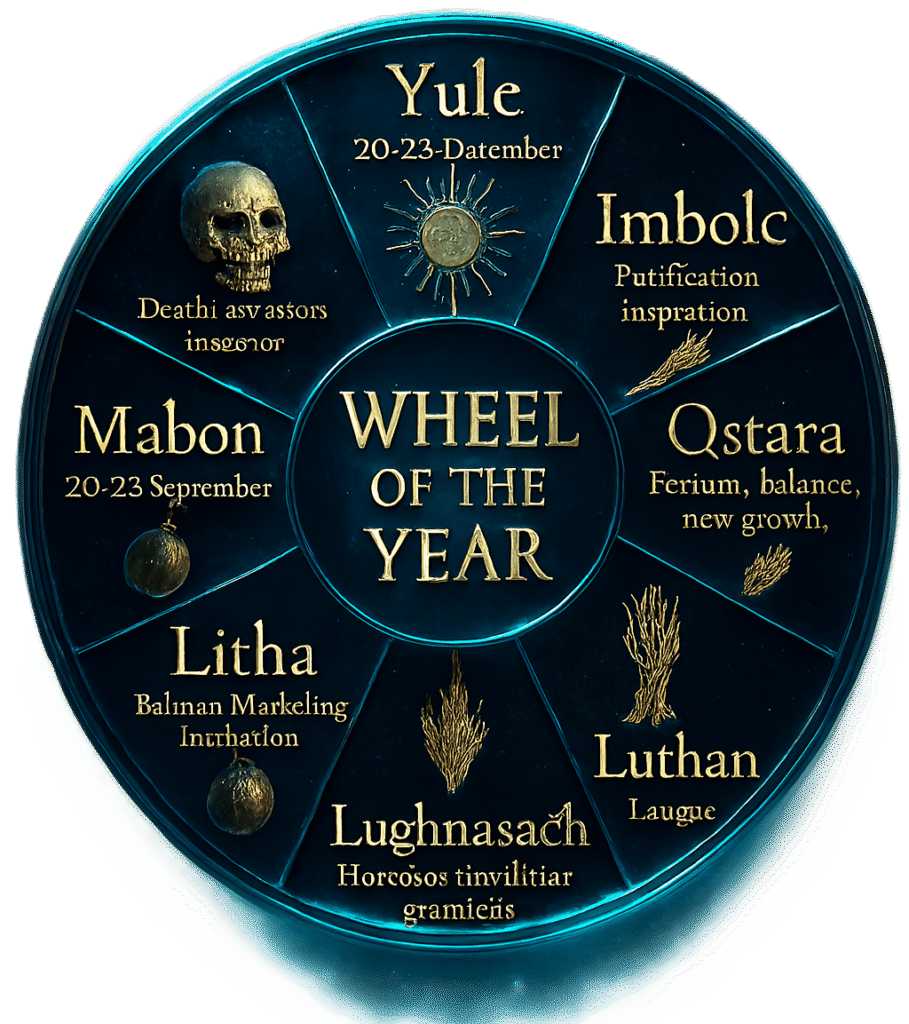
The Wheel of the Year is a sacred calendar used by modern Pagans, Wiccans, and nature-based spiritual practitioners. It marks eight seasonal festivals—known as sabbats—that celebrate the cycles of nature, agricultural rhythms, and mythic archetypes. Each sabbat reflects a unique phase in the solar year, offering opportunities for ritual, reflection, and connection to the Earth.
Origins of the Pagan Wheel of the Year
The Wheel of the Year blends ancient Celtic fire festivals with solstices and equinoxes observed across pre-Christian Europe.
- Celtic Festivals: Samhain, Imbolc, Beltane, and Lughnasadh were rooted in Gaelic agricultural and spiritual traditions.
- Solar Observances: Yule, Ostara, Litha, and Mabon align with solstices and equinoxes, often linked to megalithic sites and seasonal lore.
- Modern Revival: The Wheel was formalised in the 20th century by Wiccan pioneers, integrating folklore, ritual, and seasonal symbolism into a unified spiritual path.
The Eight Sabbats: Dates, Meaning, and Traditions
| Sabbat | Date (Northern Hemisphere) | Meaning | Common Traditions |
|---|---|---|---|
| Samhain | Oct 31 – Nov 1 | Death, ancestors, renewal | Ancestral altars, divination, fire rituals |
| Yule | Dec 20–23 (Winter Solstice) | Rebirth, light returning | Evergreen décor, Yule logs, candle magic |
| Imbolc | Feb 1–2 | Purification, inspiration | Brigid’s blessings, white candles, seed planting |
| Ostara | Mar 20–23 (Spring Equinox) | Fertility, balance, new growth | Egg rituals, floral offerings, garden rites |
| Beltane | Apr 30 – May 1 | Passion, union, vitality | Maypole dancing, fire leaping, love spells |
| Litha | Jun 20–23 (Summer Solstice) | Power, abundance, solar peak | Bonfires, sun offerings, herb gathering |
| Lughnasadh | Aug 1 | Harvest, sacrifice, gratitude | Bread baking, corn dollies, feasting |
| Mabon | Sep 20–23 (Autumn Equinox) | Balance, thanksgiving, reflection | Apple rituals, seasonal gifts, gratitude ceremonies |
Seasonal Symbolism and Folklore
Each sabbat carries rich symbolism and mythic resonance:
- Goddess Archetypes: The Maiden, Mother, and Crone cycle through birth, fertility, and wisdom.
- Solar Myths: The Oak King and Holly King represent the waxing and waning of light.
- Elemental Energies: Sabbats align with earth, air, fire, and water, guiding ritual focus and altar design.
Modern Pagan Rituals and Celebrations
Contemporary practitioners honour the Wheel through seasonal rituals, nature-based activities, and spiritual reflection.
- Altar Themes: Decorated with seasonal colours, crystals, herbs, and deity symbols.
- Circle Rituals: Include casting circles, invoking elements, and performing symbolic acts.
- Nature Connection: Foraging, planting, and outdoor meditation deepen seasonal awareness.
- Storytelling and Myth: Seasonal myths are retold to reinforce spiritual themes and ancestral memory.
Wheel of the Year Gift Ideas and Offerings
Gift-giving during sabbats focuses on symbolic, handmade, and spiritually aligned items.
- Samhain: Obsidian, skull charms, protective talismans.
- Yule: Sun-themed candles, evergreen wreaths, handmade crafts.
- Imbolc: Brigid’s crosses, white crystals, herbal bundles.
- Ostara: Painted eggs, floral garlands, fertility charms.
- Beltane: Red ribbons, honey treats, passion-infused gifts.
- Litha: Solar jewellery, sun-dried herbs, golden candles.
- Lughnasadh: Bread loaves, gratitude journals, harvest baskets.
- Mabon: Apple-themed gifts, balance tokens, seasonal preserves.
Offerings to ancestors, nature spirits, or deities often include food, drink, or ritual items placed on altars or in natural spaces.
Conclusion:
The Pagan Wheel of the Year offers a meaningful way to reconnect with nature’s rhythms, ancestral wisdom, and spiritual cycles. Whether through ritual, folklore, or seasonal gifts, each sabbat invites reflection, celebration, and renewal. Embracing the Wheel fosters a deeper connection to the Earth and the sacred turning of time.
